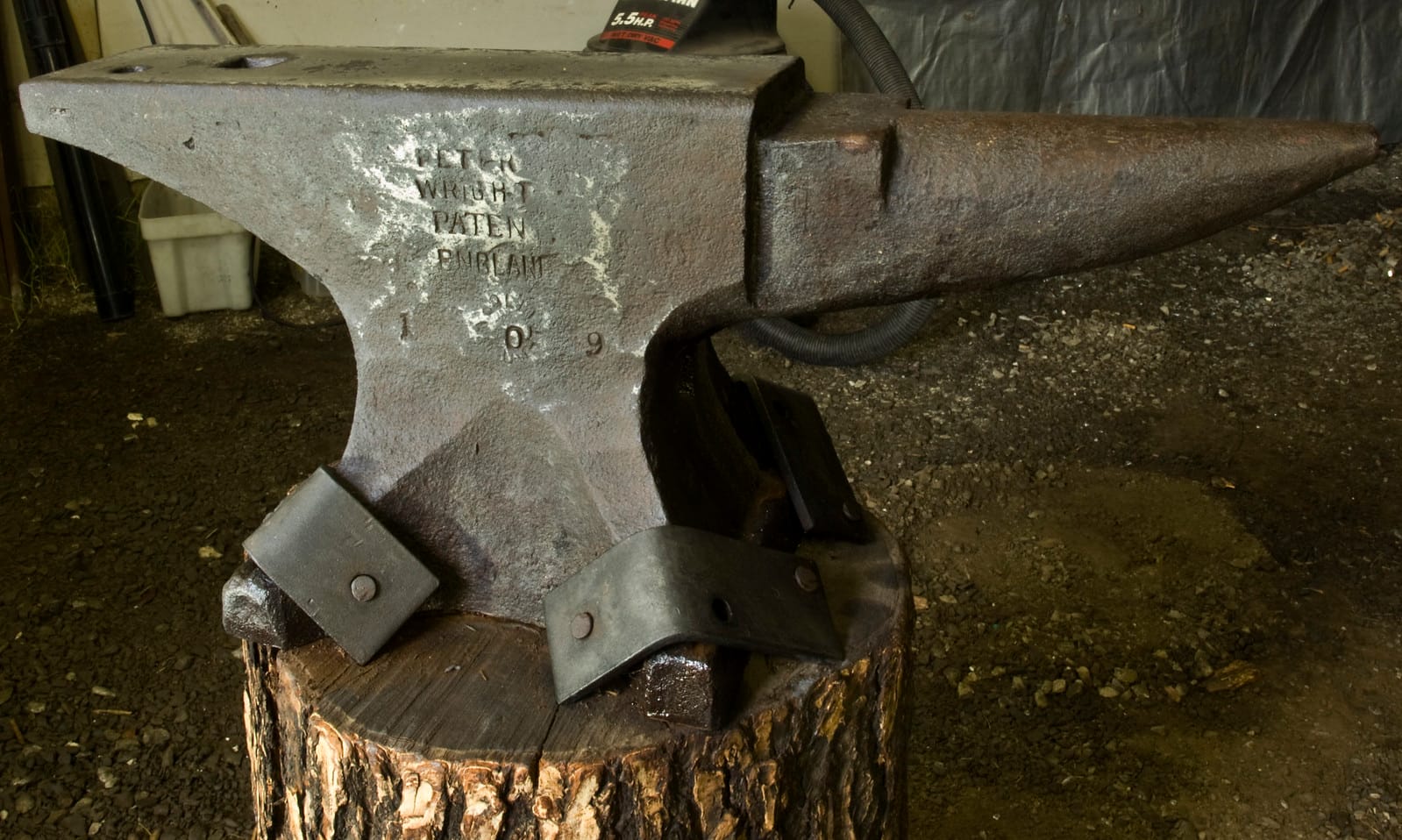Let’s dive into the captivating world of Peter Wright anvils, where time-honored craftsmanship and artistry converge. These enduring tools, steeped in blacksmithing tradition, have borne silent witness to countless hours of forging, their very presence whispering tales of molten metal and ringing hammers. Join us as we decipher the enigmatic numbers and markings etched upon their sturdy frames, unlocking secrets of their age, weight, and the fascinating legacy behind these iconic anvils. Our journey takes us to the heart of blacksmithing, where Peter Wright anvils have played a pivotal role in shaping iron into a myriad of creations, each bearing the mark of enduring craftsmanship.
History of Peter Wright Anvils
In the world of blacksmithing, few phrases carry the weight and reverence of “built like a Peter Wright anvil.” This saying speaks volumes about the legendary quality and craftsmanship associated with these anvils, meticulously crafted in Sheffield, England. More than mere tools, they represent a legacy of excellence and innovation that continues to inspire blacksmiths today.
From Humble Beginnings to Blacksmithing Royalty
The story of Peter Wright anvils begins in the late 1700s, a time when blacksmiths were as indispensable as mechanics are in the modern era. In this age of handcrafted goods, Peter Wright embarked on a mission to elevate the anvil, a tool essential to the blacksmith’s craft. His unwavering commitment to quality and precision quickly garnered attention, and the reputation of Peter Wright anvils spread rapidly through the blacksmithing community.
The “Solid Anvil” That Rocked the Blacksmithing World
In 1852, Peter Wright introduced a groundbreaking innovation: the “solid anvil.” This revolutionary design, a departure from traditional anvil construction, involved forging the entire anvil from a single, massive block of high-grade steel. The result was an anvil of unparalleled strength and durability, with a smoother and more consistent work surface than previously possible. Blacksmiths embraced this innovation, propelling Peter Wright anvils to the forefront of the industry.
More Than Just a Chunk of Metal: The Peter Wright Style
Beyond their exceptional strength, Peter Wright anvils are renowned for their distinctive aesthetic. Imagine a perfectly flat working surface, honed to precision, culminating in a subtly pointed “horn” at one end and a gracefully rounded “heel” at the other. This iconic design, often featuring a double-bick for specialized tasks, became synonymous with quality and craftsmanship.
Spotting a True Peter Wright Treasure
Even today, genuine Peter Wright anvils are highly prized possessions, sought after by collectors and blacksmiths alike. Their enduring appeal stems not only from their exceptional functionality but also from their status as tangible pieces of blacksmithing history. But how can you tell if an anvil is a true Peter Wright? Look for the distinctive Peter Wright logo and accompanying markings. The anvil’s weight and overall build quality are also key indicators. Pay close attention to the finer details—the finish, the edges—as these often reveal the mark of true craftsmanship.
A Legacy Forged in Steel
Peter Wright anvils have earned their place as icons in the world of blacksmithing. They serve as a powerful reminder that quality and innovation transcend time and trends. Whether you encounter one in a bustling workshop or a quiet museum display, these anvils tell a compelling story—a story of a family business’s dedication to excellence and the enduring allure of metalworking.
How Can You Tell How Old a Peter Wright Anvil Is?
Holding a Peter Wright anvil is like holding a piece of blacksmithing history in your hands. Each hammer blow, each dent, and scratch whispers tales of its past. But how do you decode these whispers and determine the anvil’s true age? It’s a bit like solving a puzzle, but don’t worry, certain clues can help unravel the mystery.
Cracking the Code: Markings and Weight
1. The Language of Weights
The markings etched into the side of your Peter Wright anvil are like a birth certificate, with the weight markings being the most revealing. On older anvils, those crafted before 1910, the first three digits of the weight marking can be multiplied by 14 to determine the weight in pounds. These early anvils were built to withstand tremendous force, making them noticeably heavier than their modern counterparts.
2. More Than Just Numbers
Beyond the weight markings, you might find additional engravings that resemble secret messages from the past. These could be dates or other identifying marks. Old catalogs and reference books are invaluable resources for deciphering these markings and potentially pinpointing the exact year your anvil was born.
The Stories Anvils Tell: Hardface and Condition
3. A Peek Beneath the Surface
The “hardface,” the anvil’s work surface, can also reveal clues about its age. An original, untouched hardface typically measures about 5/16 of an inch thick. If the hardface appears to have been thinned down or “trued up,” it suggests the anvil has undergone some level of refurbishment over the years.
4. Scars and Stories
Anvils are built to withstand impact, but they’re not impervious to the passage of time. Years of hammering leave their mark in the form of nicks, cuts, and possibly even welding repairs. These “imperfections” are like wrinkles and scars, each telling a tale about the anvil’s life. Generally, the more “lived-in” an anvil looks, the older it probably is.
A Word of Caution
Dating an anvil is an art, not an exact science. While these clues can provide valuable insights, there’s no foolproof formula. New discoveries are constantly being made, and our understanding of these historical tools is always evolving. Approach the dating process with patience, research diligently, and embrace the journey of uncovering your anvil’s unique story.
What Do the Numbers on a Peter Wright Anvil Mean?
You’ve got your hands on a Peter Wright anvil—that’s fantastic! Those numbers stamped on the side might seem like a secret code, but they tell a story about the anvil’s weight, providing valuable clues about its history and how it was likely used. Let’s decipher this code together.
Back in the day, they used a system called the hundredweight system. Imagine a “hundredweight” as a unit of weight equal to 112 pounds. Then you have “quarter-hundredweights,” which are, you guessed it, a quarter of that, clocking in at 28 pounds.
Those numbers on your anvil represent a combination of hundredweights, quarter-hundredweights, and extra pounds. Let’s break it down with an example. Imagine you see the numbers “2-1-14” on your anvil.
- The first number, “2,” indicates the anvil weighs two hundredweights, which is 2 x 112 pounds = 224 pounds.
- The second number, “1,” signifies one additional quarter-hundredweight, adding another 28 pounds.
- The third number, “14,” represents an extra 14 pounds.
Adding these together (224 + 28 + 14) gives you a total weight of 266 pounds—that’s one substantial piece of metal!
Why Does Weight Matter?
The weight of an anvil provides insights into its intended use. A heavier anvil, like our 266-pound example, suggests it was likely used for heavy-duty blacksmithing, providing an unyielding base for hammering large pieces of metal. A lighter anvil might have been more suitable for farriers shoeing horses or for smaller-scale metalwork.
Remember: While the hundredweight system provides a general framework, variations and exceptions exist in the world of antique tools.
Where are Peter Wright anvils from?
Peter Wright anvils, renowned for their exceptional quality and durability, hail from across the pond, specifically England. Peter Wright established his anvil-making operation in Dudley, England, and his anvils quickly gained immense popularity, particularly in the United States.
A Transatlantic Journey
Vast quantities of Peter Wright anvils were shipped from England to America, where they became a staple in blacksmithing workshops and forges across the country. Their widespread adoption in the United States speaks volumes about the quality and craftsmanship of these anvils.
Peter Wright: An Anvil Pioneer
Peter Wright was a visionary in the anvil-making world. He introduced a revolutionary two-piece anvil design, a departure from traditional methods, significantly enhancing the anvil’s strength and longevity.
Unwavering Commitment to Quality
Peter Wright’s dedication to using only the highest quality steel available further solidified his anvils’ reputation for excellence. These anvils could withstand the relentless hammering of blacksmithing work while maintaining their smooth, flat surfaces—crucial for precision metal shaping.
Enduring Legacy
Even today, Peter Wright anvils are cherished by blacksmiths and collectors alike. They are highly sought-after treasures, embodying a bygone era of craftsmanship and enduring quality. Holding a Peter Wright anvil is akin to holding a piece of history, a testament to the ingenuity and skill that went into each one.
Are Peter Wright Anvils Cast Iron?
While it’s easy to assume that all anvils are created equal, Peter Wright anvils distinguish themselves through their construction. Unlike some anvils made from cast iron, Peter Wright anvils are crafted from wrought iron, a material known for its exceptional strength and resilience.
Wrought Iron vs. Cast Iron
Think of it this way: cast iron is like a sturdy cooking pan—it serves its purpose but can crack under extreme stress. Wrought iron, on the other hand, is more akin to a well-made hand tool, designed to withstand generations of use. Peter Wright’s choice of wrought iron for his anvils speaks volumes about his commitment to quality and durability, ensuring that his anvils could endure the rigors of even the most demanding blacksmithing tasks.
Markings of Distinction
Further distinguishing Peter Wright anvils are the special markings—the maker’s name and initials—stamped directly into the metal. These markings serve as a testament to the anvil’s authenticity and the care taken in its creation. Think of these markings as an artist’s signature on a masterpiece, adding to the anvil’s unique character and historical value.
A Legacy of Craftsmanship
Peter Wright anvils are more than just tools; they are tangible representations of a bygone era’s craftsmanship, embodying durability and enduring quality. Each anvil stands as a testament to the legacy of Peter Wright and the artistry of blacksmithing.
What do numbers on the bottom of an anvil mean?
Those mysterious numbers on the bottom of your anvil aren’t random; they hold the key to unlocking its weight, encoded using a system passed down through generations of blacksmiths. Understanding this system requires a journey back in time to when English anvils made their way to America.
Cracking the Stone Weight Code
The numbers on the bottom of many English anvils reflect the “stone weight system,” a traditional English measurement system. Let’s break down how to decode this system:
- First Number (Leftmost): This number indicates the number of “hundredweights” the anvil weighs. A hundredweight, an old unit of measurement, equals 112 pounds. Multiply the leftmost number by 112 to get the weight in pounds for this part.
- Middle Number: This number represents the number of “quarter-hundredweights.” As the name suggests, a quarter-hundredweight is 28 pounds (half of a hundredweight). Multiply the middle number by 28.
- Rightmost Number: This straightforward number indicates any additional pounds the anvil weighs, typically a value less than 28 pounds.
Example:
Let’s say your anvil has the numbers “1-2-14” on the bottom. Here’s how to calculate the weight:
- 1 (leftmost number) x 112 (pounds per hundredweight) = 112 pounds
- 2 (middle number) x 28 (pounds per quarter-hundredweight) = 56 pounds
- 14 (rightmost number) = 14 pounds
Adding those three numbers (112 + 56 + 14) gives you a total weight of 182 pounds.
Variations and Exceptions
It’s important to note that not all English anvils strictly adhered to the stone weight system. Some might display their weight in pounds, while others, like Brooks anvils, used a hybrid system incorporating hundredweights and fractions.
The world of anvils is full of intriguing quirks and historical nuances. Deciphering the weight markings on your anvil is like unlocking a piece of its past, providing a glimpse into its journey through time.
How to Identify a Vintage Anvil?
Ever stumbled upon a heavy piece of metal in your grandpa’s shed and wondered if it’s a true vintage anvil? You’re not alone! Identifying vintage anvils is a blend of observation and historical knowledge. Let’s explore the telltale signs of a seasoned anvil:
Defining “Vintage”
In the world of tools, “vintage” typically refers to items made between 20 and 100 years ago. Pieces older than that often fall under the “antique” category. Keep in mind that these are general guidelines, and the lines can blur when dealing with well-used tools.
The Language of Anvils
Vintage anvils often reveal their age through distinct markings and features:
- Weighty Matters: Vintage anvils often have their weight stamped directly on them, but here’s the catch—the weight might be displayed using the old hundredweight system, potentially causing confusion for those accustomed to pounds. For instance, a stamping of “1.0.0” translates to 112 pounds!
- Lugging It Around: Those handles or protrusions on the sides of the anvil are called “lugs.” These were essential for moving these heavyweights around in the past. Many vintage anvils retain their lugs, a feature less common in modern anvils.
- Horns of a Different Era: The horn is the pointed (or sometimes rounded) part extending from the anvil’s body. Vintage horns tend to be more rounded than the sharper, more defined horns found on newer anvils.
- Imperfections Tell a Story: Unlike today’s mass-produced tools, vintage anvils were often handmade, resulting in subtle imperfections—an uneven surface or a visible mold line. These “flaws” enhance an anvil’s unique character, hinting at its age and hand-crafted origins.
Beyond the Basics: Types of Antique Anvils
Within the realm of vintage anvils, you’ll encounter specialized types:
- Bench Anvils: Small and slender, with a pointed horn, designed for delicate work like jewelry making.
- Saw Maker’s Anvils: Featuring an H-shaped body and often grooves, ideal for sharpening and setting saw teeth.
- Farrier’s Anvils: Long and thin, with a distinctive swelled horn, specifically crafted for shaping horseshoes.
What’s It Worth? Factors Affecting Anvil Value
If you stumble upon a vintage anvil and are curious about its value, several factors come into play:
- Condition: Like a well-loved book, a vintage anvil’s value hinges on its condition. Surface rust is common, but major damage or excessive wear will impact the price.
- Heavyweight Champion: In the anvil world, bigger is often better when determining value. The sheer material cost of larger anvils contributes to their worth.
- Rarity Rules: Certain types of anvils, particularly those with specialized uses, are rarer than others. A rare find in good condition can command a premium price.
A Final Word of Advice
Identifying vintage anvils is as much art as it is science. Consult experts, delve into research, and compare your findings to refine your eye. The world of vintage tools is full of fascinating discoveries!
How Much Are Old Anvils Worth?
The saying “heavy as an anvil” takes on a whole new meaning when considering the value of old anvils. Those massive anvils from old-time blacksmith shops can be worth a significant sum, and it’s not just about their weight, although that’s a major factor.
Size and Material Matter
Larger anvils, often crafted from substantial amounts of high-quality metal, were essential for heavy-duty blacksmithing tasks in the past. Collectors and enthusiasts recognize this, and the value of these hefty relics reflects their historical significance and the sheer amount of material used in their construction.
Condition is Key
Imagine finding an anvil that appears virtually untouched by time—a rare gem with minimal wear and tear. These pristine examples command higher prices than their more heavily used counterparts. Condition is a critical factor in determining an anvil’s value.
Specialized Anvils
Not all anvils were created equal. Some were designed for specific tasks, such as the smaller anvils used by jewelers or toolmakers. While these specialized anvils are fascinating in their own right, they typically don’t command the same price as the larger anvils used by blacksmiths for tasks like shoeing horses. Rarity and specialization play a role in determining value.
The Allure of Hand-Forged Anvils
Hand-forged anvils, each unique and imbued with the mark of the skilled blacksmith who crafted it, are highly sought after by collectors. These anvils, embodying both artistry and functionality, often fetch premium prices, reflecting their rarity and historical significance.
What’s the Price Tag?
The value of old anvils can range widely. A smaller anvil in decent condition might sell for a few hundred dollars, while a large, well-preserved anvil, especially one with a unique history or features, could be worth thousands. Size, condition, type, and rarity all factor into the equation.
Hidden Treasures in Plain Sight
If you’re fortunate enough to have an old anvil in your possession, consider having it evaluated by a knowledgeable antique dealer or appraiser. They can provide insights into its history and potential value. You might be sitting on a piece of history more valuable than you realize.
Remember, old anvils aren’t just chunks of metal; they are tangible links to a bygone era, whispering stories of blacksmiths and craftsmen. Whether you’re a collector, a history buff, or just curious about these enduring tools, old anvils continue to captivate and intrigue.
How Can You Tell if an Anvil is Good?
Whether you’re in the market for an anvil or have inherited one and are curious about its quality, evaluating an anvil is akin to assessing a used car—you need to look beyond the surface.
1. Built to Last: Can it Take a Beating?
Anvils are designed to endure repeated hammer blows, so durability is paramount.
- Material Matters: Anvils made from forged steel or cast iron are generally the most durable. These materials can withstand significant impact without succumbing to excessive wear and tear.
- Inspect for Damage: Thoroughly examine the anvil for cracks or significant damage. While minor surface imperfections are acceptable, cracks are red flags, indicating potential structural weakness.
2. Flat as a Pancake: The Importance of a Smooth Surface
The anvil’s top surface, known as the “face,” is where the magic of metal shaping happens. A flat, even surface is crucial for achieving consistent results.
- Why is Flatness Important? Trying to work on an uneven anvil is like building a house on a shaky foundation—frustrating and likely to yield subpar results. A flat face ensures that hammer blows are distributed evenly, providing greater control over the metal being worked.
- Checking for Flatness: Use a ruler or straightedge to check for gaps or dips across the anvil’s surface.
3. Solid as a Rock: Weight and Stability
Weight and stability are essential for a good anvil. You don’t want it bouncing around while you’re working.
- Size Matters: Within reason, a heavier anvil is generally more desirable. It absorbs more impact from hammer blows, reducing vibration and making for a more comfortable forging experience.
- Stability is Key: An unstable anvil is not only frustrating but also potentially dangerous. Ensure the base is wide and stable to prevent wobbling during use.
4. The Horn of Plenty: Checking Shape and Condition
The anvil’s horn, the pointed extension at one end, is crucial for bending and shaping metal.
- Length and Shape: A longer horn provides greater versatility. Assess its overall shape and condition, looking for cracks, bends, or other damage that could compromise its strength.
Additional Tips
- Sound Check: Some blacksmiths tap the anvil with a hammer and listen for a clear, ringing sound, which suggests a solid structure. A dull thud might indicate an internal problem, although the reliability of this “ring test” is debated.
- Rebound: A quality anvil should have a slight bounce or “rebound” when struck with a hammer. This rebound can significantly impact the forging experience, particularly for delicate work.
- Price vs. Value: While it’s tempting to opt for the cheapest anvil available, remember that a good anvil is an investment. It’s worth spending a bit more for a quality tool that will last a lifetime.
Try Before You Buy
If possible, test an anvil before purchasing it. Get a feel for its weight, stability, and rebound. An experienced blacksmith can also provide valuable insights into an anvil’s quality and suitability for your needs.
What Year Was the Anvil Made?
Dating an anvil isn’t as straightforward as checking a birthday cake for candles. It requires a bit of detective work, piecing together clues from its design, construction, and any markings present.
Anvils Through the Ages
Anvils have a long and storied history, dating back over 6,000 years to ancient civilizations in Turkey and Iran. Early anvils were fashioned from materials like meteorites and hard stones. As metalworking techniques advanced, iron anvils emerged, eventually giving way to the superior strength and durability of cast steel anvils.
Clues to Unraveling the Mystery
Here’s how to approach dating your anvil:
- Maker’s Mark: Check for a maker’s mark—a name, logo, or initials stamped on the anvil, particularly for anvils made from the mid-1800s onward. Online resources and collectors’ forums can help decipher these marks.
- Shape and Features: Anvil designs evolved over time. Early anvils tend to be simpler, while later models often incorporate more specialized features.
- Material: Anvils made from cast steel likely date back to the late 19th century or later, coinciding with the rise of cast steel anvil production.
- Expert Consultation: Antique dealers, experienced blacksmiths, or historical societies can be invaluable resources for dating anvils. Their expertise and knowledge can provide insights based on years of experience.
A Note of Caution
Dating an anvil is not an exact science. Records aren’t always available, and some anvils might have replacement parts that complicate the dating process. However, even if you can’t pinpoint the exact year, the journey of gathering clues and unraveling your anvil’s history adds another layer of intrigue to this timeless tool.
How much does a Wright anvil weigh?
Wright anvils, renowned for their durability and craftsmanship, are built to withstand the test of time. This robustness, however, comes at a literal price—weight. Crafted from steel, Wright anvils are heavier than their cast iron counterparts.
Weight Ranges
The weight of a Wright anvil can vary depending on its size and intended use. Smaller, more portable Wright anvils might weigh around 130 pounds (59 kilograms), while larger anvils designed for heavy-duty forging can tip the scales at over 200 pounds (91 kilograms).
Material and Size Considerations
The difference in weight boils down to the amount of steel used in the anvil’s construction. A larger anvil requires more material, naturally increasing its weight.
A Worthy Investment
Whether you opt for a lighter, more portable Wright anvil or a heavier-duty model, these anvils are built to last. Their weight is a testament to their solid construction and ability to withstand the demands of blacksmithing.
Further Exploration
If you’re eager to delve deeper into the history and craftsmanship of Wright anvils, consider exploring resources like the article “Peter Wright Anvils: A History of Quality and Innovation,” linked below. This article provides a wealth of information about these iconic anvils.
- Wondering where rap music originated? Check out our detailed article on the history of rap. history of rap justin timberlake jimmy fallon
- Visit Raystown Lake, a beautiful reservoir for swimming and boating. history of raystown lake pa
- Discover the captivating Elverhøj Museum of History & Art and embark on a journey through time and artistic expression. elverhoj museum of history & art
- How many weeks is 40 days: Quick Conversion Guide for Accurate Results - March 31, 2025
- How many feet is 300 meters? 984 Feet: Understand Length Conversions Easily - March 31, 2025
- Senior at What Age: Benefits & Eligibility Guide - March 29, 2025

















2 thoughts on “Forging a Legacy: Delving into the History of Peter Wright Anvils”
Comments are closed.